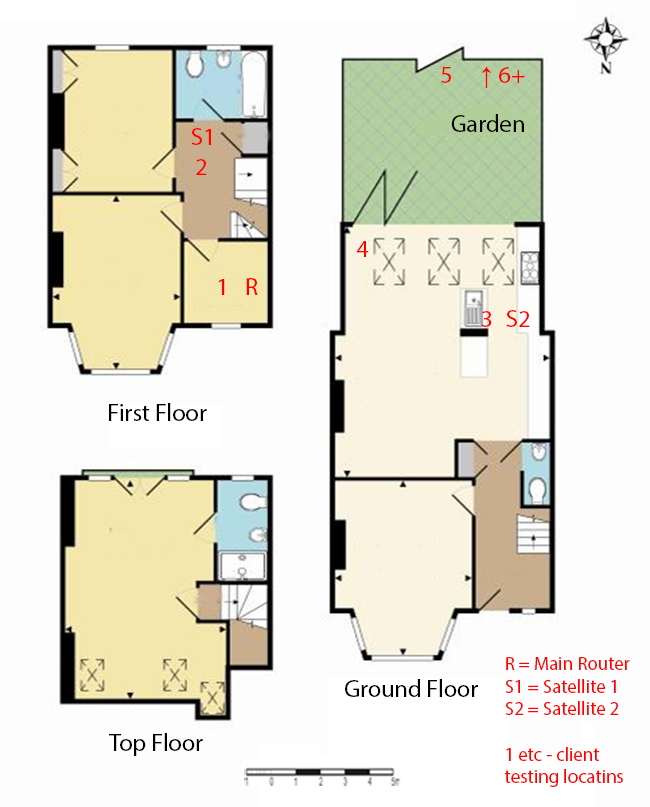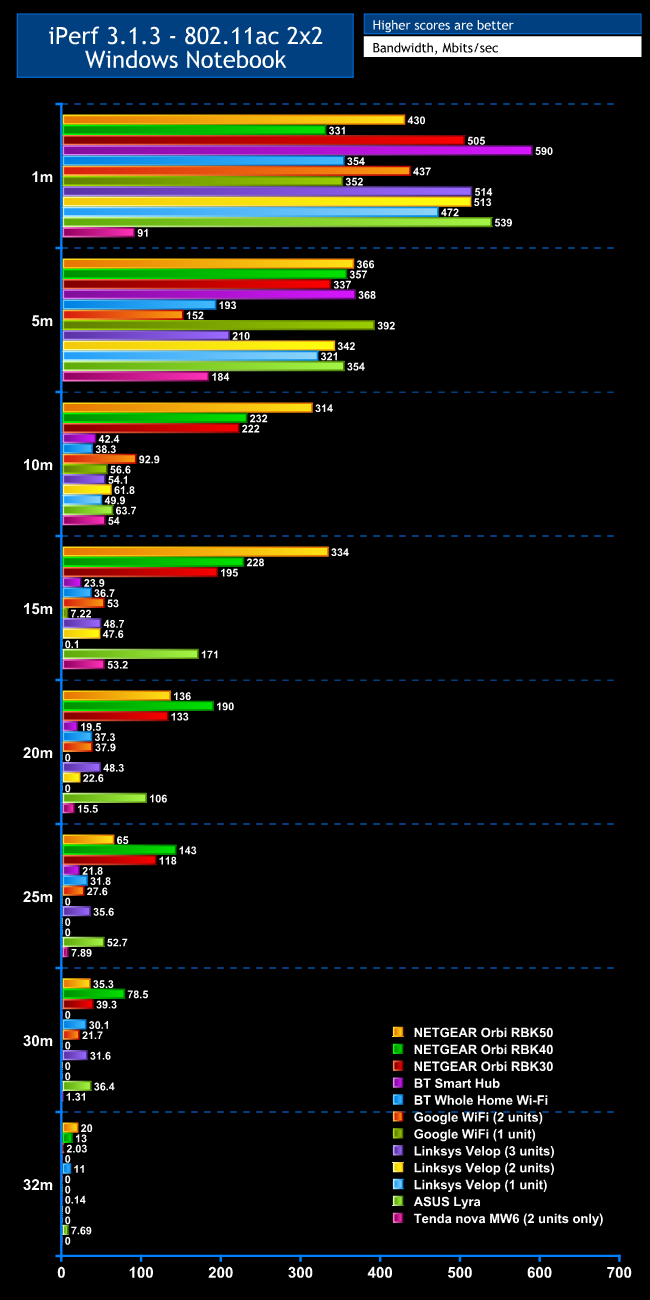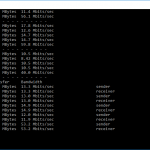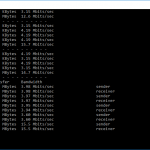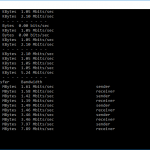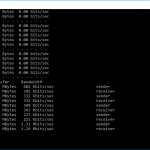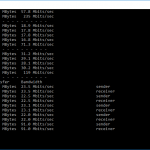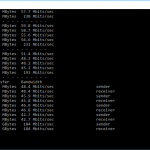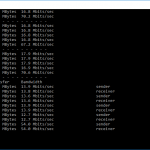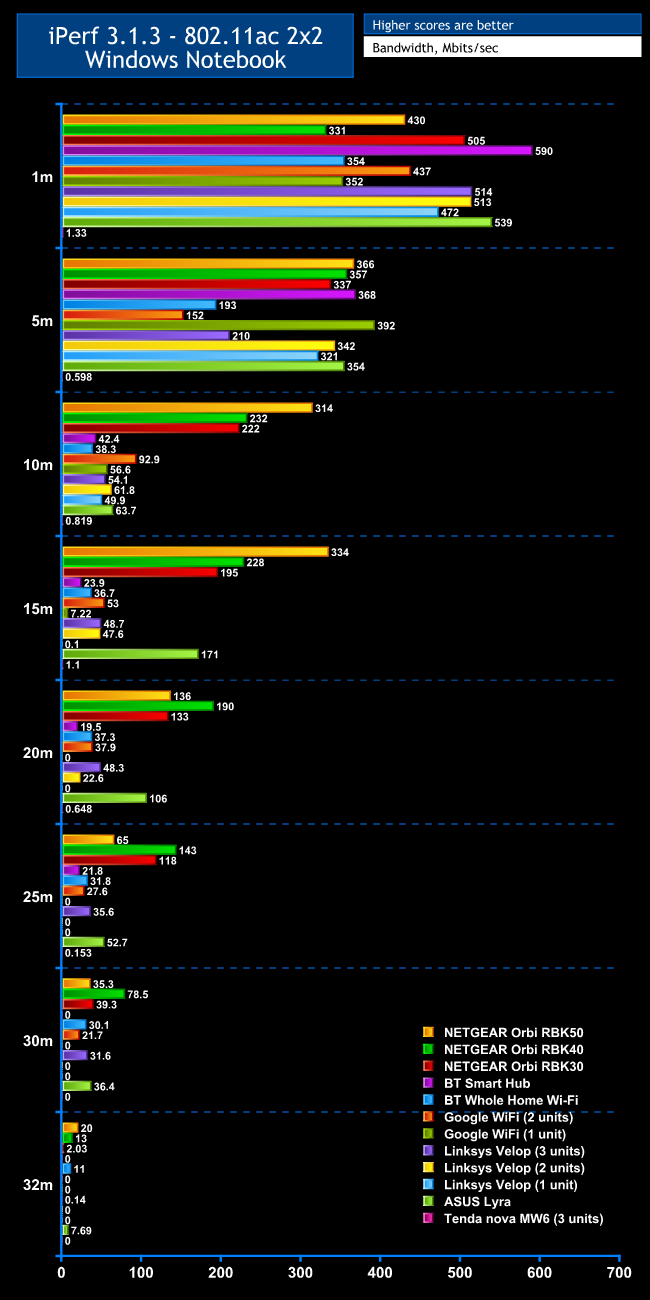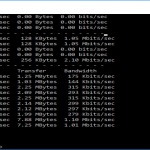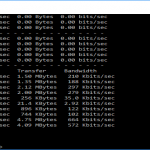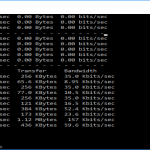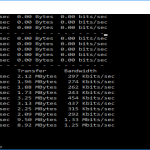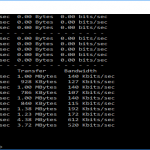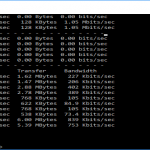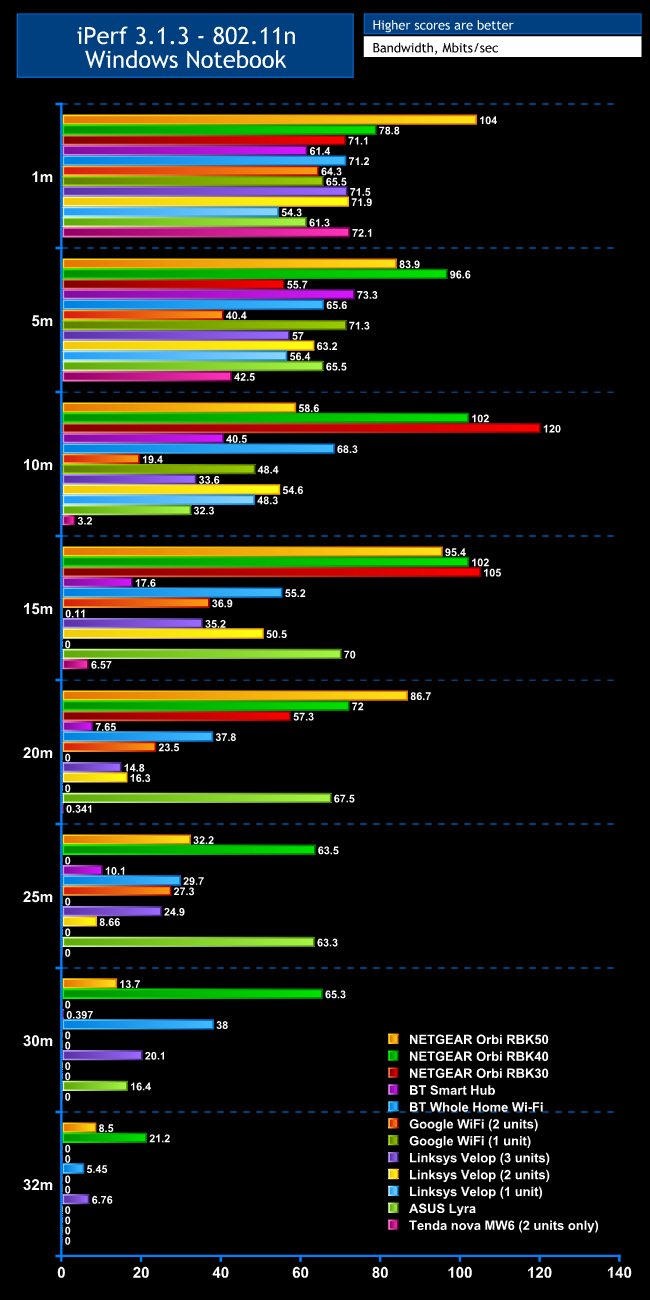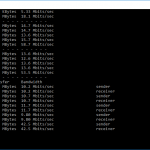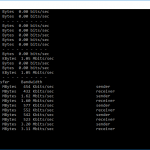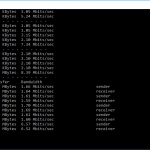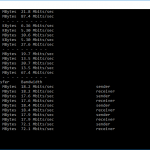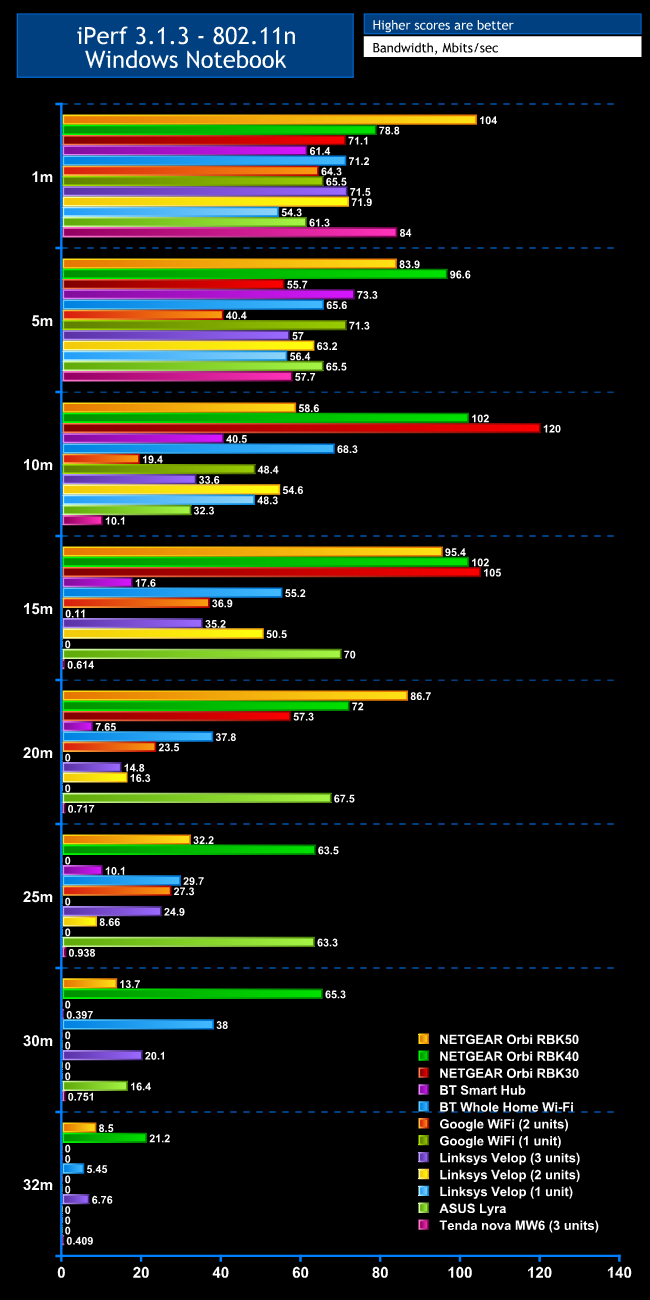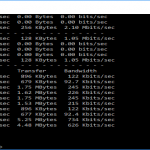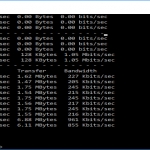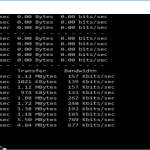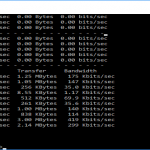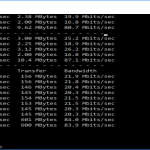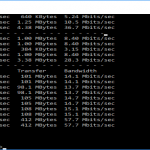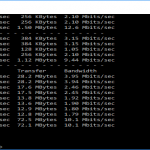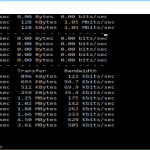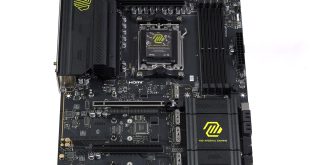We tried to replicate the testing from our Ultimate Mesh WiFi Router Shootout as closely as possible with the Tenda nova MW6. However, we no longer had the Apple Macbook Pro in our possession, so had to leave this set of tests out, and the Acer laptop was replaced with an HP one that has an identical 802.11ac WiFi specification.
We replicated the positions from the Ultimate Mesh WiFi Router Shootout, with eight different locations for our test notebooks. The clients used were an HP Spectre 13 X2 notebook with 2×2 802.11ac WiFi, and an older HP Folio 13 which maxes out at 3×3 802.11n WiFi.
In each case, we used the freely available iPerf 3.1.3 software, which stresses a network by sending packets of random data and measures the throughput. One system acts as a server, and the other as a client, as data is sent between them. In all cases, we used an Armari Windows 10 workstation connected to the primary nova MW6 unit via Gigabit Ethernet as the server, so that the WiFi was always the slowest connection.
These are the iPerf commands we used:
For the server: iperf3 –s –i 1
For the client: iperf3 –c <IP Address> –P 4 –i 1 –t 60
Note that the client command sends four streams of data simultaneously, simulating a multi-client connection as closely as possible with just one client. It takes 60 throughput readings at one second intervals and then averages the result.
The above diagram shows the layout of the house we used for testing. Note that we didn't test on the top floor of the house because this was directly above the first floor and wouldn't have provided much of a range test. Instead, we used two locations on the same floor as the router (the first floor), then more distant locations on the ground floor extending out the back of the house into the garden.
Each test location, numbered in the diagram above, was approximately 5m away from the last one.
With the mesh networking and standalone router products used for comparison, location 1 was very near to the router, around 1m away. The next location – 2 – was around 5m away, with a wall in the way, but on the same floor. Location 3 was on the floor below, so had walls and a floor in between, but was a further 5m away. Location 4 was the last one actually inside the house. Locations 5 to 7 were then 5m further down the garden. Location 8 was only 2m further down, as this was the end of the garden, but also behind a shed, so posed a significant challenge that only a few mesh WiFi systems can cope with.
We should also say a few words about the location of the satellites. The routers or primary unit were always placed in the same location, in the first floor study next to the broadband. In the case of three-unit mesh systems such as BT Whole Home Wi-Fi and the top Velop option, the second and third satellites were placed at S1 and S2.
With the two-unit Google WiFi, the second unit was placed at S1, due to the recommendation of the setup software. However, in the case of the Orbi, it was possible to place the second unit at S2, due to the signal strength from these systems.
For the Tenda nova MW6 system, we placed the primary unit in location R, with the first satellite at S1, and the second at S2. However, although we eventually managed to get the second satellite to join the mesh when in close proximity to the primary unit, it completely failed to do this when placed at S2, so all initial testing was performed with just two units in the mesh.
We were later sent a production version of the nova MW6, where all three units bonded correctly, so this testing was done with units at R, S1 and S2.
802.11ac 5GHz
Even at close proximity, where the lack of the third unit wouldn't cause an issue, the nova MW6 doesn't offer very impressive 802.11ac performance. In fact, the 1m result of 91Mbits/sec is way behind every other mesh WiFi system we have tested, as well as the BT Smart Hub.
Matters improve a little at 5m, where the throughput of 184Mbits/sec beats a two-unit Google WiFi setup and comes close to BT's Whole Home WiFi as well as the three-unit Linksys Velop configuration. But it's still less than half what the best mesh WiFi systems can muster at this range.
The 54Mbits/sec result at 10m is a bit more respectable, placing it in the pack with the majority of mesh WiFi options, but way behind what NETGEAR's Orbis can deliver. Interestingly, this is where we normally place the second satellite, showing that the Tenda nova MW6's inability to bond its second satellite to the mesh at this location is not due to lack of WiFi range.
The nova MW6 managed 53.2Mbits/sec at 15m, which actually one of the better results, putting it on par with a two-unit Google WiFi setup and slightly faster than Linksys's Velop with two or three units. However, the NETGEAR Orbis are still way ahead, and the ASUS Lyra is more than three times as fast too.
Performance drops off after this, with a just-about-usable 15.5Mbits/sec at 20m, a barely usable 7.89Mbits/sec at 25m, and an unusable 1.31Mbits/sec at 30m. This is followed by no connection in our 32m “behind the bike shed” position.
Although the Tenda nova MW6 is achieving a decent range with two units, it's sorely missing that third unit beyond 15m, and never reaches high 802.11ac bandwidth even at close proximity.
Once we received the production version of the nova MW6, we retested to see if this would show improvement.
As you can see the answer with 802.11ac was a resounding “no”. The nova MW6 didn't seem to be supplying significant bandwidth at all at any range. We were so surprised by this result we retested a number of times, then tested our notebook and desktop with a different mesh system. But the latter performed as expected, implying something seriously wrong with the Tenda nova MW6.
802.11n 2.4GHz
The 2.4GHz 802.11n results are even less distinguished than for 5GHz 802.11ac. Within 1m, the throughput of 72.1Mbits/sec is respectable, and in fact the third fastest we have recorded. However, performance at 5m drops to the second slowest with 42.5Mbits/sec, and it's downhill from there. Throughput at 10m is just 3.2Mbits/sec – barely usable.
This rises a little to 6.57Mbits/sec at 15m, but completely drops off the scale with 0.341Mbits/sec at 20m, and no signal at all beyond that.
Overall, the Tenda nova MW6 may well have performed better if the third unit had worked, but we can only test what we are sent. Although this was an early sample, and Tenda may fix the bonding issue with a firmware update, in its current state the nova MW6 is one of the least speedy mesh WiFi systems we have tested.
Again, we retested with the production bundle we were sent later.
This is a little more encouraging than for 802.11ac, although performance still drops like a stone beyond 10m. The nova MW6 struggles on with a trickle of bandwidth to our maximum distance, but this is still just about the worst mesh WiFi system we have tested in terms of performance.
 KitGuru KitGuru.net – Tech News | Hardware News | Hardware Reviews | IOS | Mobile | Gaming | Graphics Cards
KitGuru KitGuru.net – Tech News | Hardware News | Hardware Reviews | IOS | Mobile | Gaming | Graphics Cards


